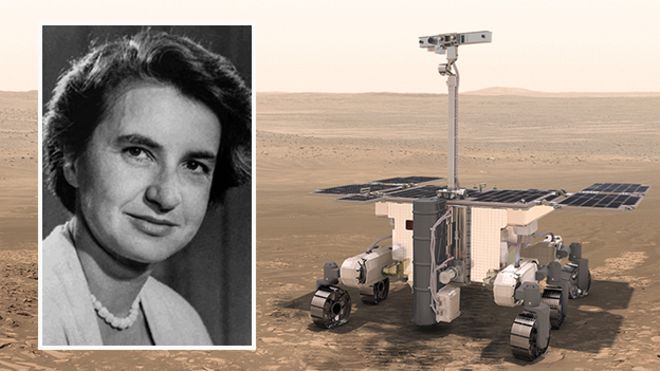
THE ROSALIND Franklin rover will explore Mars as part of the next rover mission to the Red Planet. So why was one of the ExoMars Mars rovers named Rosalind Franklin?
The UK made ExoMars rover, due to roam the surface of the red planet in 2021, has been named after UK scientist and co-discoverer of the structure of DNA – Rosalind Franklin. The name was revealed this week by Science Minister Chris Skidmore and British European Space Agency (ESA) Astronaut Tim Peake in the ‘Mars Yard’ at Airbus Defence and Space UK in Stevenage, where the rover is being built. Tim Peake, British ESA Astronaut said: “This rover will scout the Martian surface equipped with next-generation instruments – a fully-fledged automated laboratory on Mars. With it, we are building on our European heritage in robotic exploration, and at the same time devising new technologies.”
What is the ExoMars Rover Rosalind Franklin?
The ExoMars rovers are an audacious attempt to conclusively prove the existence of life on Mars.
A growing scientific consensus believe the Red Planet’s apparently inhospitable exterior might well be concealing evidence of alien life past and present.
Some scientists think a thick layer of permafrost may be sheltering tiny, organic molecules.
And one of the ExoMars rovers will drill through to where this organic layer is believed to exist.
Who was Rosalind Franklin?
One of the ExoMars rovers being sent to Mars next year will bear the name of DNA pioneer Rosalind Franklin.
The honour follows a public call for suggestions that drew 36,000 responses.
Astronaut Tim Peake unveiled the name near to the Airbus factory in Stevenage, UK, where the ExoMars rover is being constructed.
Rosalind Franklin had a vital role in the discovery of the structure of deoxyribonucleic acid, more commonly known by its abbreviation DNA.
It was Rosalind Franklin’s X-ray images that enabled her colleagues James Watson and Francis Crick to decipher its iconic double-helix shape.
Franklin’s early death from ovarian cancer aged just 37, meant she never tragically received the recognition lauded on her male colleagues.
“In the last year of Rosalind’s life, I remember visiting her in hospital on the day when she was excited by the news of the Soviet Sputnik satellite – the very beginning of space exploration,” Franklin’s sister, Jenifer Glynn, said.
“She could never have imagined that over 60 years later there would be a rover sent to Mars bearing her name, but somehow that makes this project even more special.”
The six-wheeled ExoMars rover will not land on the Martian surface until 2021.
The Rosalind Franklin ExoMars rover will be laden with cutting-edge scientific tools to probe the Red Planet, including a powerful drill, a next-generation radar and an organic molecule analyser.
The ExoMars programme is, in fact already underway.
An orbiter has been exploring the gases emitted from Mars’ atmosphere for the past two years.
Part scientist, part messenger service and part delivery-bot, the orbiter carried the ill-fated Schiaparelli lander in tow on its journey to Mars.
But Schiaparelli crash-landed, ending its Mars mission in October 2016.
US space agency NASA will launch another, as yet unnamed, rover next year.
Scientists and engineers hope these rovers’ metal wheels will eventually pave the way for human feet.
Paul Meacham, lead systems engineer on the ExoMars rover project, said: “A lot of the scientific results from these missions will then actually direct where a human mission might go and who we might send on a mission like that.
Will we send a biologist or a geologist? Or both?
“These missions are really, really important in leading us towards that human mission.”
This project has also encountered difficulties, with NASA announcing a failed heat shield test, although this should not delay the rover’s launch.





























